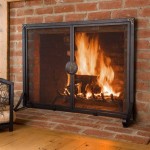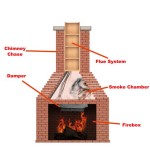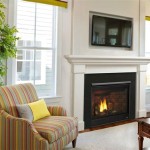Understanding Indoor Wood Fireplace Inserts
An indoor wood fireplace insert is a self-contained heating appliance designed to be installed within an existing masonry or factory-built fireplace. It offers an efficient and environmentally conscious alternative to open fireplaces, which are known for their low heating efficiency and contribution to indoor air pollution. The primary function of a fireplace insert is to transform a traditional fireplace from an inefficient aesthetic feature into a substantial heat source for the home.
Fireplace inserts are typically constructed of cast iron or steel, materials known for their durability and heat retention capabilities. These materials allow the insert to absorb heat from the burning wood and radiate it into the surrounding living space. Unlike open fireplaces, which lose a significant amount of heat up the chimney, inserts are designed to maximize heat transfer. This is achieved through a closed combustion system, well-insulated firebox, and often, the integration of blowers that circulate warm air into the room.
The installation process generally involves placing the insert into the fireplace opening and connecting it to a dedicated chimney liner. This liner is crucial for safely venting the combustion byproducts and preventing creosote buildup, which can lead to chimney fires. Professional installation is highly recommended to ensure proper fitting, secure connection, and adherence to local building codes and safety regulations.
Increased Heating Efficiency
One of the key benefits of a wood fireplace insert is its significantly higher heating efficiency compared to traditional fireplaces. Open fireplaces are notoriously inefficient, often drawing more warm air from the room than they produce, resulting in a net loss of heat. This is because a large percentage of the heat generated goes directly up the chimney, while the fire also pulls in cold air from other parts of the house to fuel the combustion process. Fireplace inserts, in contrast, are designed to trap and radiate heat into the room. Their closed combustion system minimizes air leakage, and the insulated firebox helps retain heat. Modern wood fireplace inserts often boast efficiency ratings of 70% or higher, meaning that a larger portion of the wood's energy is converted into usable heat for the home.
Furthermore, many inserts are equipped with blowers, which are electric fans that circulate warm air more effectively. These blowers force air through channels around the firebox, capturing the heat and distributing it evenly throughout the room. This forced-air circulation helps to overcome the natural stratification of heat, where warm air rises to the ceiling while the floor remains cold. The result is a more comfortable and consistent temperature throughout the living space.
The increase in heating efficiency translates directly into lower heating costs. By using a wood fireplace insert as a primary or supplementary heat source, homeowners can reduce their reliance on central heating systems, such as furnaces or heat pumps. This can lead to substantial savings on energy bills, especially during the colder months. The amount of savings will vary depending on factors such as the size and insulation of the home, the type of wood used, and the frequency of use.
Improved Safety Features
Wood fireplace inserts offer a range of safety improvements over traditional open fireplaces. Open fireplaces pose several safety risks, including the potential for sparks and embers to escape the firebox and ignite nearby flammable materials. They also generate a large amount of smoke, which can backdraft into the home if the chimney is not properly functioning. Fireplace inserts address these risks through their closed combustion system and controlled ventilation.
The closed firebox of an insert prevents sparks and embers from escaping, minimizing the risk of house fires. The glass door further enhances safety by providing a barrier between the fire and the room, preventing accidental contact with flames. Some models also include features such as automatic shut-off mechanisms that activate if the door is left open or if the insert overheats.
Another important safety aspect of fireplace inserts is their compatibility with dedicated chimney liners. These liners are specifically designed to vent the combustion gases produced by the insert and prevent them from leaking into the home. They also help to reduce the buildup of creosote, a flammable substance that can accumulate in the chimney and cause chimney fires. Regular inspection and cleaning of the chimney liner are essential for maintaining safe operation.
Environmental Considerations
Modern wood fireplace inserts are designed to burn wood more cleanly and efficiently than older models and open fireplaces, contributing to improved air quality. The Environmental Protection Agency (EPA) has established regulations to limit the amount of particulate matter that wood-burning appliances can emit. EPA-certified inserts meet these standards by incorporating advanced combustion technologies that promote more complete burning of the wood fuel.
These technologies often include features such as secondary combustion, which involves reburning the unburned gases and particulate matter produced during the initial combustion process. This secondary combustion reduces emissions and increases the overall efficiency of the insert. Catalytic combustors, which are integrated into some models, further reduce emissions by oxidizing unburned gases at a lower temperature.
By reducing emissions, wood fireplace inserts help to minimize their impact on air quality. This is particularly important in areas where wood burning is common, as it can contribute to elevated levels of particulate matter in the air. Burning seasoned or dried wood is also crucial for cleaner and more efficient combustion. Wet or green wood produces more smoke and creosote, increasing emissions and reducing the heat output of the insert.

Expedition Ii Wood Insert Forge Flame

Wood Burning Fireplace Inserts Insert Installation
.aspx?strip=all)
Cost Of Operating A Wood Insert Cord Calculator Regency

Ventis Hei240 Wood Burning Insert Rockford Chimney

Wood Burning Fireplace Insert Frederick Md Repair Install

The Best Wood Burning Fireplace Inserts Or Stoves Ecohome

Wood Fireplace Inserts We Install Regency Napoleon

Fireplace Inserts Make Fireplaces More Attractive And Efficient Woodstoves Patio

Should I Use A Fireplace Insert Or Wood Stove To Heat Up My Home

The Best Wood Burning Fireplace Inserts Or Stoves Ecohome
Related Posts








